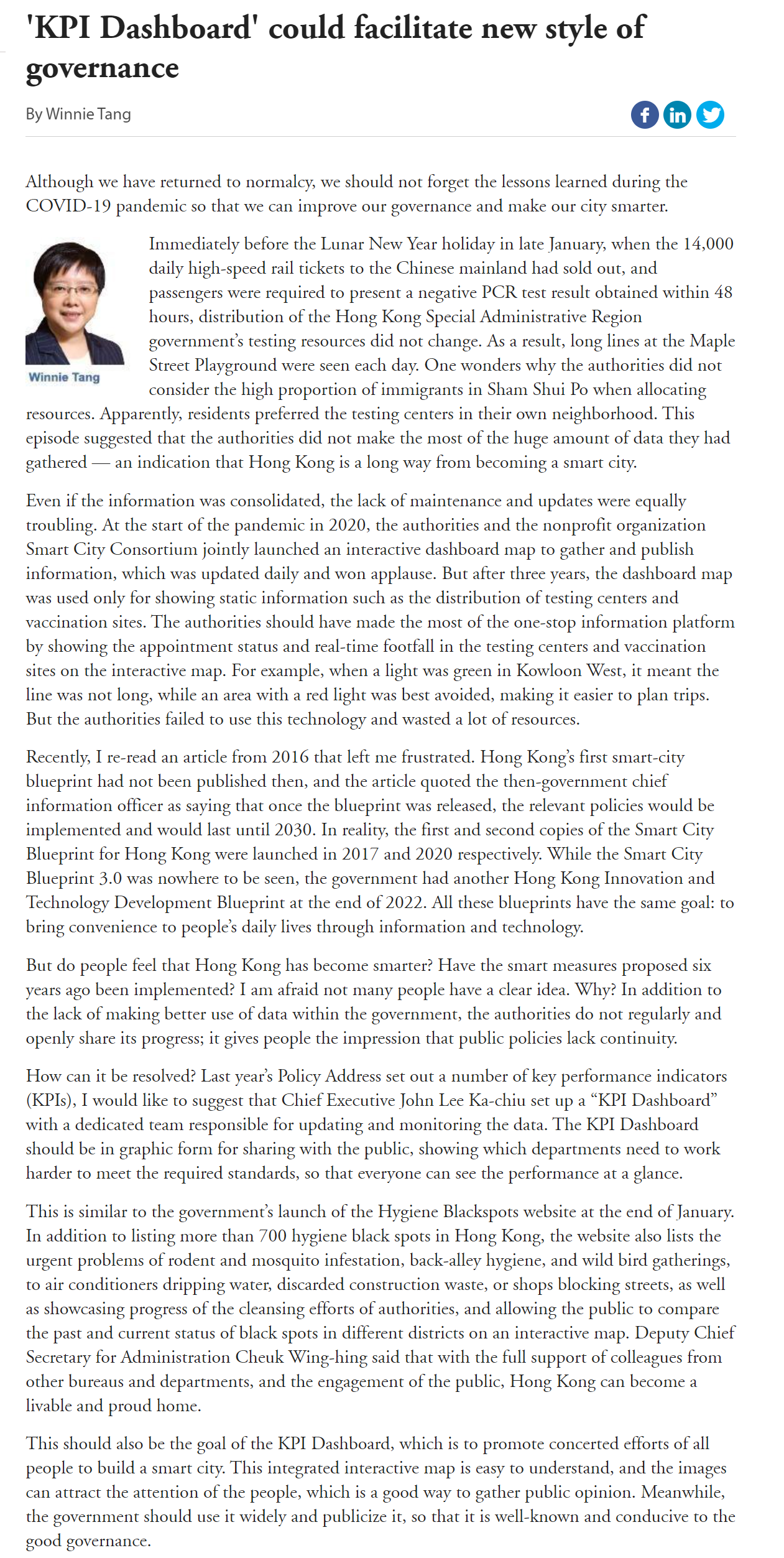網上版請按此

'KPI Dashboard' could facilitate new style of governance
Although we have returned to normalcy, we should not forget the lessons learned during the COVID-19 pandemic so that we can improve our governance and make our city smarter.
Immediately before the Lunar New Year holiday in late January, when the 14,000 daily high-speed rail tickets to the Chinese mainland had sold out, and passengers were required to present a negative PCR test result obtained within 48 hours, distribution of the Hong Kong Special Administrative Region government’s testing resources did not change. As a result, long lines at the Maple Street Playground were seen each day. One wonders why the authorities did not consider the high proportion of immigrants in Sham Shui Po when allocating resources. Apparently, residents preferred the testing centers in their own neighborhood. This episode suggested that the authorities did not make the most of the huge amount of data they had gathered — an indication that Hong Kong is a long way from becoming a smart city.
Even if the information was consolidated, the lack of maintenance and updates were equally troubling. At the start of the pandemic in 2020, the authorities and the nonprofit organization Smart City Consortium jointly launched an interactive dashboard map to gather and publish information, which was updated daily and won applause. But after three years, the dashboard map was used only for showing static information such as the distribution of testing centers and vaccination sites. The authorities should have made the most of the one-stop information platform by showing the appointment status and real-time footfall in the testing centers and vaccination sites on the interactive map. For example, when a light was green in Kowloon West, it meant the line was not long, while an area with a red light was best avoided, making it easier to plan trips. But the authorities failed to use this technology and wasted a lot of resources.
Recently, I re-read an article from 2016 that left me frustrated. Hong Kong’s first smart-city blueprint had not been published then, and the article quoted the then-government chief information officer as saying that once the blueprint was released, the relevant policies would be implemented and would last until 2030. In reality, the first and second copies of the Smart City Blueprint for Hong Kong were launched in 2017 and 2020 respectively. While the Smart City Blueprint 3.0 was nowhere to be seen, the government had another Hong Kong Innovation and Technology Development Blueprint at the end of 2022. All these blueprints have the same goal: to bring convenience to people’s daily lives through information and technology.
But do people feel that Hong Kong has become smarter? Have the smart measures proposed six years ago been implemented? I am afraid not many people have a clear idea. Why? In addition to the lack of making better use of data within the government, the authorities do not regularly and openly share its progress; it gives people the impression that public policies lack continuity.
How can it be resolved? Last year’s Policy Address set out a number of key performance indicators (KPIs), I would like to suggest that Chief Executive John Lee Ka-chiu set up a “KPI Dashboard” with a dedicated team responsible for updating and monitoring the data. The KPI Dashboard should be in graphic form for sharing with the public, showing which departments need to work harder to meet the required standards, so that everyone can see the performance at a glance.
This is similar to the government’s launch of the Hygiene Blackspots website at the end of January. In addition to listing more than 700 hygiene black spots in Hong Kong, the website also lists the urgent problems of rodent and mosquito infestation, back-alley hygiene, and wild bird gatherings, to air conditioners dripping water, discarded construction waste, or shops blocking streets, as well as showcasing progress of the cleansing efforts of authorities, and allowing the public to compare the past and current status of black spots in different districts on an interactive map. Deputy Chief Secretary for Administration Cheuk Wing-hing said that with the full support of colleagues from other bureaus and departments, and the engagement of the public, Hong Kong can become a livable and proud home.
This should also be the goal of the KPI Dashboard, which is to promote concerted efforts of all people to build a smart city. This integrated interactive map is easy to understand, and the images can attract the attention of the people, which is a good way to gather public opinion. Meanwhile, the government should use it widely and publicize it, so that it is well-known and conducive to the good governance.
Dr. Winnie Tang
Adjunct Professor, Department of Computer Science, Faculty of Engineering; Department of Geography, Faculty of Social Sciences; and Faculty of Architecture, The University of Hong Kong